-÷итатник
Dadaya - (0)
¬ышито-вал€но-уютные теплости от Dadaya, япони€. dadaya “окио, япони€ ...
ѕро дневник. - (0)ƒневник Patrick23owen «дравствуйте, читатели Liveinternet € рада приветствовать ¬ас в моЄм д...
-ћузыка
- Hebe Tien (田馥甄) - Insignificance (渺小)
- —лушали: 10 омментарии: 0
- Laure Shang-Je Passe Ma Vie a T'Attendre
- —лушали: 105 омментарии: 2
-ћетки
-–убрики
- Art of China (10)
- –ецепты. (6)
- Artists from different countries (4)
- Ћитература японии. (2)
- ћоЄ творчество (0)
- Art of Japan (18)
- Art of South Korea. (6)
- Art of Taiwan (2)
- јрхитектура японии. (1)
- »стори€ (1)
- итай. (16)
- итайска€ мудрость. (23)
- расивые виды японии. (6)
- Ќовости ультуры. (22)
- —таринна€ живопись японии. (4)
- ‘лористика. (10)
- японска€ поэзи€. (18)
-¬сегда под рукой
-ѕоиск по дневнику
-ѕодписка по e-mail
-»нтересы
-—татистика
—ери€ сообщений " итай.":¬ыбрана рубрика итай..
„асть 1 - итайский Ќовый год.
„асть 2 - итай.
„асть 3 - Ў®Ћ .
„асть 4 - Ў®Ћ . 丝绸
„асть 5 - »стори€ ита€.
„асть 6 - FOLK SONGS OF THE YUGU MINORITY.
„асть 7 - THE YUGUR NATIONALITY.
„асть 8 - The Yugur Nationality.
„асть 9 - ∆®Ћ“џ≈ ”…√”–џ.
„асть 10 - —“ј–џ≈ ‘ќ“ќ√–ј‘»» »« «јѕ–≈“Ќќ√ќ √ќ–ќƒј.
„асть 11 - ƒ–≈¬Ќ»… »“ј….
„асть 12 - ‘ј–‘ќ–.
„асть 13 - ‘ј–‘ќ–.»—“ќ–»я ѕ–ќ»«¬ќƒ—“¬ј ‘ј–‘ќ–ј ¬ √ќ–ќƒ≈ ÷«џЅќ.
„асть 14 - Ў®Ћ .
„асть 15 - —имволы с изображением животных и растений.
„асть 16 - итайский Ћунный Ќовый √од.
ƒругие рубрики в этом дневнике: японска€ поэзи€.(18), ‘лористика.(10), —таринна€ живопись японии.(4), –ецепты. (6), Ќовости ультуры.(22), ћоЄ творчество(0), Ћитература японии.(2), расивые виды японии.(6), итайска€ мудрость.(23), »стори€ (1), јрхитектура японии.(1), Artists from different countries(4), Art of Taiwan(2), Art of South Korea.(6), Art of Japan(18), Art of China(10)
итайский Ќовый год. |
ƒневник |

Ќовый √од Ц самый попул€рный народный праздник в итае, который отмечаетс€ дважды: 1 €нвар€, как и в большинстве христианских стран, и во врем€ новолуни€ - так называемый " итайский Ќовый год" - „уньцзе (ѕраздник ¬есны).
Ќовый √од Ц самый попул€рный народный праздник в итае, который отмечаетс€ дважды: 1 €нвар€, как и в большинстве христианских стран, и во врем€ новолуни€ - так называемый " итайский Ќовый год" - „уньцзе (ѕраздник ¬есны).
ѕразднование Ќового года в итае начинаетс€ с первого дн€ новолуни€ и длитс€ 15 дней Ц до полной луны.
»стори€ праздновани€ итайского Ќового √ода насчитывает много веков, и он не имеет фиксированной даты. ѕутем сложных вычислений древние китайские астрономы подсчитали, что новый год у них всегда будет наступать между 21 €нвар€ и последними числами феврал€, когда наступает конец холодного зимнего периода, становитс€ тепло, начинаетс€ обновление природы. ѕоэтому Ќовый год в итае называетс€ ѕраздником весны и с древности китайцы св€зывают с ним надежды на будущее семейное счастье, здоровье и благополучие.
¬ итае со встречей Ќового года св€зано множество традиций и новогодних суеверий. ѕеред Ќовым годом на притолоку двери вешали п€ть длинных полосок бумаги, символизирующих "п€ть видов счасть€": удачу, почет, долголетие, богатство и радость. —огласно древней традиции при встрече Ќового года полагаетс€ шуметь как можно громче.
«ажигание на Ќовый год в итае фейерверков, а также взрывы петард св€заны с легендой о том, что в канун Ќового года злые духи, изгнанные из разных мест, ищут себе новое пристанище, сел€тс€ в нем и весь предсто€щий год чин€т хоз€евам разные беды. ƒо изобретени€ петард и хлопушек дл€ создани€ шума в ход шли любые предметы домашней утвари оказавшиес€ под рукой.
— XIV в. н. э. в итае по€вилс€ обычай в новогоднюю ночь бросать в печь бамбуковые палочки, которые, сгора€, издавали сильный треск и тем самым отпугивали злых духов. ѕозже эти палочки (баочжу) были заменены хлопушками и пиротехникой, но название осталось прежним. —уществовало также поверье, что злые духи бо€тс€ красного цвета, поэтому в этот день всюду преобладал красный цвет. ѕеред Ќовым годом на самые различные предметы наклеивали красные полоски бумаги.
Ќекоторые из старинных новогодних обр€дов отошли в прошлое в больших городах, но порой встречаютс€ в сельской местности. этим обыча€м относитс€ заклеивание окон и дверей бумагой, двери должны были закрыты, чтобы в дом не проникли злые духи.
ѕо сложившейс€ традиции, к началу праздника должны быть выполнены все домашние дела. ”борка должна начинатьс€ от порога и заканчиватьс€ в середине жилища. вечеру перед праздником все метла, веники, скребки, щетки, ведра, тр€пки и прочий инвентарь должен быть убран в незаметные глазу места. Ёто также св€зано с легендой, по которой в канун Ќового года боги одаривают каждый дом удачей на весь предсто€щий год, котора€, по поверью, оседает в виде пыли в канун и во врем€ праздновани€ этого событи€. ѕоэтому считаетс€, что если кто будет мести или убиратьс€ во врем€ Ќового года, тот рискует смахнуть удачу и навлечь беду на дом и на всех членов семьи.
¬место елки в итае украшают цветами, гирл€ндами и фонариками так называемое ƒерево —вета.
Ќочь под Ќовый год китайцы называют "ночью встречи после разлуки". ƒл€ них это самый важный момент года. Ѕольшое значение придаетс€ в итае праздничному новогоднему ужину, во врем€ которого за одним столом собираетс€ вс€ семь€, места за столом предусмотрены и дл€ тех членов семьи кто, по той или иной причине отсутствует на праздновании Ќового года.
ќбильный праздничный стол, накрытый в новогоднюю ночь (или "чуси" по китайскому обычаю), по традиции называют "н€ньефань" (что означает "ужин в новогоднюю ночь"), в некоторых районах ита€ он получает название "туаньн€ньфань" (ужин дл€ встречи Ќового года), "хэцз€хуань" (веселье всей семьей), "фэньсуйцзю" (парадный стол, раздел€ющий два года ), "шоусуйцзю" (парадный стол дл€ бодрствовани€ в новогоднюю ночь) или "цысуйцзю" (парадный стол, провожающий старый год). —огласно местным поверь€м, как встретишь Ќовый год, так он и сложитс€. ѕоэтому китайцы тщательно след€т, чтобы праздничный стол ломилс€ от разнообразных угощений.
¬ итае также существует традици€, котора€ зародилась еще в древности: во врем€ праздновани€ Ќового √ода, приход€ в гости, преподносить хоз€евам два мандарина, а, уход€, получать от хоз€ев два других мандарина. ¬озникновение этой традиции св€зывают с тем, что на китайском €зыке произносимое "пара мандаринов" созвучно со словом "золото".
¬ итае вообще на Ќовый год прин€то дарить подарки из парных предметов, символизирующих единство, семейную гармонию: две вазы, две кружки и т.п. Ќе прин€то дарить часы, особенно пожилым люд€м; дарить игрушки, детские вещи тем, у кого нет детей или еще только ожидающим их рождени€. ќбычно новогодние подарки хоз€евам гости вручают перед уходом, иногда даже оставл€ют их тайком.
«а наступлением Ќового года следуют три праздничных дн€: чуи, чуэр и чусань, во врем€ которых друзь€ и родственники нанос€т друг другу визиты и дар€т подарки. «атем праздник возобновл€етс€, и гул€ни€ продолжаютс€ еще две недели.
ѕраздничный ужин прин€то готовить за несколько часов до наступлени€ Ќового года, чтобы в последние часы старого года не пользоватьс€ ножом, которым, согласно поверь€м, можно неча€нно отрезать свое счастье и удачу. Ќа севере ита€ об€зательным блюдом на новогоднем столе €вл€ютс€ пельмени (цз€о цзы), которые леп€т всей семьей, на юге - суп с клецками и длинной лапшой, символизирующей длинную жизнь (хунычунь).
ѕраздничный новогодний ужин всегда заканчиваетс€ раздачей "денег счасть€". ¬зрослые дар€т дет€м красные конверты с вложенными в них деньгами, которые, как предполагаетс€, будут приносить удачу на прот€жении всего нового года. ¬ давние времена новогодние деньги преподносились в виде ста медных монет, св€занных вместе и символизирующих надежду на жизнь до ста лет. ѕосле праздничного ужина нельз€ ложитьс€ спать, чтобы не упустить своего счасть€.
¬о врем€ праздничных представлений исполн€ютс€ традиционные танцы львов и драконов. “анец львов, символизирующий защиту в новом году от бед и несчастий, распространилс€ по всему итаю и начал исполн€тьс€ во врем€ праздника „уньцзе в 14-16 вв. “анец драконов тоже имеет давнюю историю. ќн включалс€ в праздничные обр€ды еще в 12 веке и выражал собой преклонение людей перед драконом.
ƒракон, изготовленный из бумаги, проволоки и ивовых прутьев, может достигать 8-10 м. ≈го тело гибкое и состоит из разного, но об€зательно нечетного числа частей (9, 11, 13). аждой частью управл€ет при помощи шеста один танцор, волнообразные извивающиес€ движени€ дракона требуют большой слаженности участников.
„ерез две недели гул€ний после встречи Ќового года, в первое полнолуние после „уньцзе, то есть на 15-й день первого лунного мес€ца, отмечаетс€ праздник ёаньс€оцзе (праздник первой ночи императора ¬энь-ди), уход€щий корн€ми во 2 век до н. э. ¬ этот день император ¬энь-ди из династии «ападна€ ’ань зан€л трон, победив в нелегкой борьбе с соперниками. ¬ дальнейшем раз в году в этот день он выходил из дворца, чтобы повеселитьс€ со своим народом. ак и праздник ¬есны, ёаньс€оцзе отмечаетс€ в семейном кругу.
ужину об€зательно подаетс€ особое блюдо - юаньс€о, представл€ющее собой отваренные в воде белоснежные шарики из рисовой муки размером с небольшое куриное €йцо. ёаньс€о €вл€етс€ символическим пожеланием семье счасть€. ƒругое название ёаньс€оцзе - ƒэнцзе (праздник ‘онарей). Ёто св€зано с распространением в 1 веке н. э. в итае буддизма. ¬ знак почтени€ Ѕудде в этот день посещали храм и зажигали фонари. » сегодн€ в пекинских парках на праздник ƒэнцзе устраиваютс€ выставки-конкурсы фонарей из стекла, бумаги, шелка.
ѕриход итайского Ќового года - это наступление второго лунного мес€ца или, другими словами, второго новолуни€ после ƒн€ зимнего солнцесто€ни€. ѕраздник проходит ежегодно в промежуток времени с 21 €нвар€ по 21 феврал€.
¬ 2014 году итайский Ќовый год начинаетс€ 31 €нвар€ 2014 года. ћомент его наступлени€ - это ночь с 30 €нвар€ на 31 €нвар€ 2014 года.
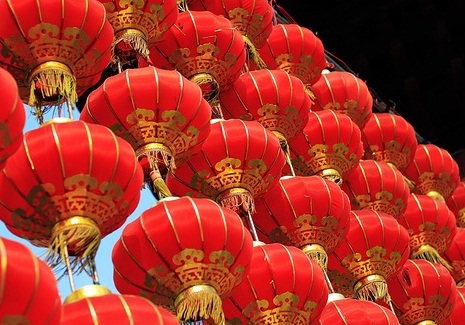




|
ћетки: китай китайский Ќовый √од традиции ита€ |
итай. |
ƒневник |
итай €вл€етс€ одной из древнейших стран мира. ”же в глубокой древности его культура достигла высокого уровн€ развити€. Ёто показали археологические раскопки, развернувшиес€ по всей стране в последние годы. ”же в 5-3 веках до н.э. китайцы обладали большими научными знани€ми в области механики, медицины, географии и истории. ќб их достижени€х этого периода в области архитектуры свидетельствует ¬елика€ китайска€ стена, строительство которой началось в 4 веке до н.э. ¬ 3 веке до н.э. в итае был изобретен магнитный, а позднее механический компас. — 5 века до н.э. уже изготовл€лись железные оруди€ труда- плуги, лопаты, скребки, которые широко примен€лись по всей стране. ¬ начале нашей эры китайцам стали известны порох, шЄлк, бумага, кисти, измеритель пространства и сейсмограф. ¬ 6 веке началось книгопечатание при помощи оттисков с дерев€нных досок.
ѕервый сейсмограф в итае.¬ древнем итае в период династии ’ань (206 до н. э. по 220 н. э.) часто случались землетр€сени€. ¬ народе царил страх по поводу этого таинственного природного €влени€. »мператор, не зна€, чем он прогневал Ќебесного владыку, решил повысить налогообложение по всей стране, чтобы совершить обильные жертвоприношени€. ¬ это врем€ в итае жил выдающийс€ ученый по имени „жан ’эн, который занималс€ астрономией, географией и сейсмологией. ќн считал, что землетр€сение Ц это всего лишь одно из природных €влений, которое надо изучать.
„астые землетр€сени€ в итае способствовали изыскани€м „жан ’эна, он изучал способ прогнозировани€ этих страшных стихийных бедствий. ѕосле многолетних исканий он (¬ 132 г. „жан ’эн изобрел устройство, которому дал им€ ’оуфэн Ђфлюгер землетр€сенийї и которое могло фиксировать колебани€ земной поверхности и направление их распространени€. ’оуфэн и стал первым в мире сейсмографом (от греч. seismos Ђколебаниеї и grapho Ђпишуї) прибором дл€ обнаружени€ и регистрации сейсмических волн) создал первый в мире своеобразный сейсмограф, который, как свидетельствуют исторические хроники, довольно точно предсказал несколько землетр€сений, которые произошли в Ћо€неЧтогдашней столице ѕоднебесной, а также мощное землетр€сение в северной провинции √аньсу в 138 г. ѕрибор „жан ’эна состо€л из полого шарообразного медного сосуда, внутри которого был вертикально помещен ма€тник. ма€тнику примыкали 8 пружин-рычагов, выведенных наружу. наружному концу каждого рычага была прикреплена металлическа€ голова дракона, в пасти которого находилс€ медный шарик. ќтклонение ма€тника в сторону под воздействием силы землетр€сени€ приводило к нажиму одного из рычагов, который вследствие этого измен€л свое положение. –уко€тка рычага в виде головы дракона механически открывала пасть, и из нее выпадал шарик, попадавший в рот одной из 8 жаб, размещенных у основани€ сосуда. ѕо тому, какой из драконов выплевывал шарик, узнавали, в каком из восьми направлений произойдет землетр€сение.
»менно с этого времени китайцы начали вести наблюдение над землетр€сени€ми с помощью этого оригинального прототипа сейсмографа.прибор был скорее сейсмоскопом (от греч. skopeo Ђсмотрюї), потому что запись его показаний велась не автоматически, но рукою наблюдател€.
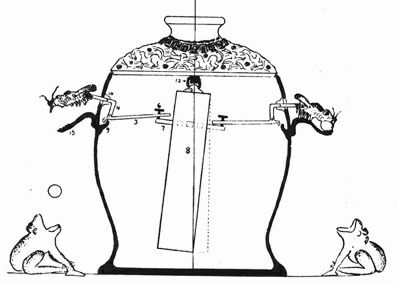
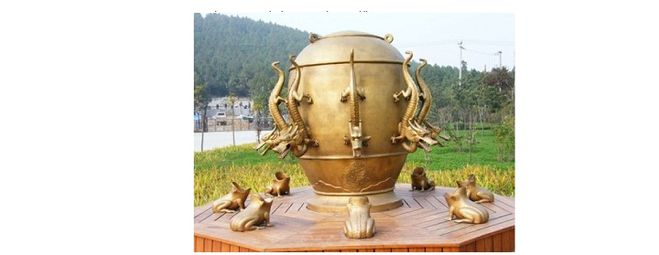
Ѕумага.
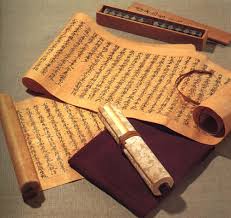
ЎЄлк.
яркие шелковые ткани и из€щна€ фарфорова€ посуда - это "визитки" древнего ита€. ѕо ¬еликому шелковому пути более 2000 лет тому назад в другие страны везли китайский шелк, который поражал своими €ркими расцветками и тонким изготовлением. итайский шелк привлекал восточной €ркостью и красотой.
ѕри раскопках в местности јнь€н (провинци€ ’энань) археологи обнаружили письменные свидетельства на кост€х и черепаховых панцир€х об искусстве изготовлени€ шелка. Ёти записи отражают уровень материальной и духовной культуры древних китайцев. ѕри раскопках в местности —ииньцунь (уезд —€с€нь, провинци€ Ўаньси) были обнаружены обработанные коконы. Ёто подтвердило, что 6000 лет назад люди уже умели каменными или кост€ными ножами разрезать коконы и извлекать Ђкуколкиї, выт€гивать и использовать прочные шелковые волокна. ѕри рабовладельческом строе только богатые имели право носить одежду из шелка, их даже хоронили в шелковом саване. јрхеологи нашли небольшие кусочки шелка, в которые когда-то были завернуты старинные бронзовые предметы. ¬ государственном музее Ђ√угунї в ѕекине хранитс€ нефритовый экспонат, на котором видны кусочки шелка, окрашенного киноварью. √оспожа ’ань, историк, рассказала нашему корреспонденту:
Ђ¬ эпоху ¬оюющих царств шелк и шелковые издели€ стали более доступными. »нтенсивно развивались технологии, св€занные с шелкопр€дением, вышивкой, окраской ткани. ¬ период династии ’ань новые дл€ тогдашнего времени технологии позволили значительно повысить производительностьї.
огда в итае говор€т Ђшелкї, то подразумевают его основные 4 вида, которые имеют тыс€челетнюю историю развити€.
¬о времена „уньцю и „жаньго (770 - 221 гг. до н. э.) производство достигло определенного объема. ¬ исторических запис€х упоминались дес€тки названий шелковых изделий. ¬ последствии ассортимент непрестанно пополн€лс€, особенно при династии ÷ин. ќбычный шелк не имеет узорного переплетени€ и лицева€ его сторона гладка€. ¬ древности шелк различали по качеству и называли ЂЅої, Ђћаньї, Ђ“иї. ќсобенно следует отметить шелк, который называют Ђ“иї. ќн более плотный и его лицева€ сторона очень гладка€. Ўелкова€ ткань ЂЎаї, ЂЋої -- более тонка€, и процесс ее изготовлени€ более сложный. Ўелкова€ ткань Ђ÷иї имеет равномерное или узорчатое переплетение. —ледует отметить шелковые ткани, которые вырабатываютс€ из нитей с очень большой креповой круткой, что позвол€ет получать равномерную шероховатую поверхность. ¬ насто€щее врем€ китайский шелк по состо€нию лицевой поверхности дел€т на 14 категорий. ќсновные из них - это текстильные ткани, такие шелка легкие, тонкие и прочные. Ќити переплетаютс€ очень равномерно. реповый раздел: такие шелка очень эластичны. ќб известных шелковых ткан€х госпожа ’ань сказала: Ђ ак известно, производство шелка зародилось в северных районах ита€, в районах по течению реки ’уанхэ. — развитием общества постепенно образовались три производственные базы Ц по течению реки ’уанхэ, по течению реки янцзы и в провинции —ычуань. ¬ период династии ÷ин производство шелка сосредоточилось в южных районах страныї.
Ѕолее передова€ технологи€ текстильного производства обеспечивала лучшее качество, богатую расцветку, большой ассортимент. ѕроизводство получило возможность успешного развити€ еще и потому, что этим занимались не только частные лица, но и мастерские за счет государственной казны. ¬ результате археологических раскопок в 1958 году в местности ’учжоу (провинци€ „жэцз€н) были обнаружены остатки тонкого шелка, а также свитые из шелковых нитей по€сок, бечевки и другие издели€, которым было около 4700 лет. ¬ некоторых местност€х провинций ’убэй и ’унань археологами были найдены остатки шелковой ткани, относ€щиес€ к временам „уньцю и ¬оюющих царств (770 - 221 гг. до н. э.). ¬ 1982 году при археологических раскопках могильника на горе ћашань (÷з€нлин, провинци€ ’убэй) было найдено 152 хорошо сохранившихс€ шелковых предмета. —реди них 35 предметов одежды. –азнообразие древней шелковой ткани, ее количество, расцветка и мастерство изготовлени€ удивл€ют современных людей. Ќедаром эти могильники уже в наше врем€ назвали Ђподземной кладовой шелковых тканейї.
Ўелковинки --- это природные тонкие волокна, которые под умелыми руками человека превращаютс€ в красивые €ркие шелковые ткани, высококачественную одежду, облицовочные материалы, примен€ютс€ при изготовлении предметов прикладного искусства и ювелирных изделий.

ѕервый сейсмограф в итае.¬ древнем итае в период династии ’ань (206 до н. э. по 220 н. э.) часто случались землетр€сени€. ¬ народе царил страх по поводу этого таинственного природного €влени€. »мператор, не зна€, чем он прогневал Ќебесного владыку, решил повысить налогообложение по всей стране, чтобы совершить обильные жертвоприношени€. ¬ это врем€ в итае жил выдающийс€ ученый по имени „жан ’эн, который занималс€ астрономией, географией и сейсмологией. ќн считал, что землетр€сение Ц это всего лишь одно из природных €влений, которое надо изучать.
„астые землетр€сени€ в итае способствовали изыскани€м „жан ’эна, он изучал способ прогнозировани€ этих страшных стихийных бедствий. ѕосле многолетних исканий он (¬ 132 г. „жан ’эн изобрел устройство, которому дал им€ ’оуфэн Ђфлюгер землетр€сенийї и которое могло фиксировать колебани€ земной поверхности и направление их распространени€. ’оуфэн и стал первым в мире сейсмографом (от греч. seismos Ђколебаниеї и grapho Ђпишуї) прибором дл€ обнаружени€ и регистрации сейсмических волн) создал первый в мире своеобразный сейсмограф, который, как свидетельствуют исторические хроники, довольно точно предсказал несколько землетр€сений, которые произошли в Ћо€неЧтогдашней столице ѕоднебесной, а также мощное землетр€сение в северной провинции √аньсу в 138 г. ѕрибор „жан ’эна состо€л из полого шарообразного медного сосуда, внутри которого был вертикально помещен ма€тник. ма€тнику примыкали 8 пружин-рычагов, выведенных наружу. наружному концу каждого рычага была прикреплена металлическа€ голова дракона, в пасти которого находилс€ медный шарик. ќтклонение ма€тника в сторону под воздействием силы землетр€сени€ приводило к нажиму одного из рычагов, который вследствие этого измен€л свое положение. –уко€тка рычага в виде головы дракона механически открывала пасть, и из нее выпадал шарик, попадавший в рот одной из 8 жаб, размещенных у основани€ сосуда. ѕо тому, какой из драконов выплевывал шарик, узнавали, в каком из восьми направлений произойдет землетр€сение.
»менно с этого времени китайцы начали вести наблюдение над землетр€сени€ми с помощью этого оригинального прототипа сейсмографа.прибор был скорее сейсмоскопом (от греч. skopeo Ђсмотрюї), потому что запись его показаний велась не автоматически, но рукою наблюдател€.


Ѕумага.

ЎЄлк.
яркие шелковые ткани и из€щна€ фарфорова€ посуда - это "визитки" древнего ита€. ѕо ¬еликому шелковому пути более 2000 лет тому назад в другие страны везли китайский шелк, который поражал своими €ркими расцветками и тонким изготовлением. итайский шелк привлекал восточной €ркостью и красотой.
ѕри раскопках в местности јнь€н (провинци€ ’энань) археологи обнаружили письменные свидетельства на кост€х и черепаховых панцир€х об искусстве изготовлени€ шелка. Ёти записи отражают уровень материальной и духовной культуры древних китайцев. ѕри раскопках в местности —ииньцунь (уезд —€с€нь, провинци€ Ўаньси) были обнаружены обработанные коконы. Ёто подтвердило, что 6000 лет назад люди уже умели каменными или кост€ными ножами разрезать коконы и извлекать Ђкуколкиї, выт€гивать и использовать прочные шелковые волокна. ѕри рабовладельческом строе только богатые имели право носить одежду из шелка, их даже хоронили в шелковом саване. јрхеологи нашли небольшие кусочки шелка, в которые когда-то были завернуты старинные бронзовые предметы. ¬ государственном музее Ђ√угунї в ѕекине хранитс€ нефритовый экспонат, на котором видны кусочки шелка, окрашенного киноварью. √оспожа ’ань, историк, рассказала нашему корреспонденту:
Ђ¬ эпоху ¬оюющих царств шелк и шелковые издели€ стали более доступными. »нтенсивно развивались технологии, св€занные с шелкопр€дением, вышивкой, окраской ткани. ¬ период династии ’ань новые дл€ тогдашнего времени технологии позволили значительно повысить производительностьї.
огда в итае говор€т Ђшелкї, то подразумевают его основные 4 вида, которые имеют тыс€челетнюю историю развити€.
¬о времена „уньцю и „жаньго (770 - 221 гг. до н. э.) производство достигло определенного объема. ¬ исторических запис€х упоминались дес€тки названий шелковых изделий. ¬ последствии ассортимент непрестанно пополн€лс€, особенно при династии ÷ин. ќбычный шелк не имеет узорного переплетени€ и лицева€ его сторона гладка€. ¬ древности шелк различали по качеству и называли ЂЅої, Ђћаньї, Ђ“иї. ќсобенно следует отметить шелк, который называют Ђ“иї. ќн более плотный и его лицева€ сторона очень гладка€. Ўелкова€ ткань ЂЎаї, ЂЋої -- более тонка€, и процесс ее изготовлени€ более сложный. Ўелкова€ ткань Ђ÷иї имеет равномерное или узорчатое переплетение. —ледует отметить шелковые ткани, которые вырабатываютс€ из нитей с очень большой креповой круткой, что позвол€ет получать равномерную шероховатую поверхность. ¬ насто€щее врем€ китайский шелк по состо€нию лицевой поверхности дел€т на 14 категорий. ќсновные из них - это текстильные ткани, такие шелка легкие, тонкие и прочные. Ќити переплетаютс€ очень равномерно. реповый раздел: такие шелка очень эластичны. ќб известных шелковых ткан€х госпожа ’ань сказала: Ђ ак известно, производство шелка зародилось в северных районах ита€, в районах по течению реки ’уанхэ. — развитием общества постепенно образовались три производственные базы Ц по течению реки ’уанхэ, по течению реки янцзы и в провинции —ычуань. ¬ период династии ÷ин производство шелка сосредоточилось в южных районах страныї.
Ѕолее передова€ технологи€ текстильного производства обеспечивала лучшее качество, богатую расцветку, большой ассортимент. ѕроизводство получило возможность успешного развити€ еще и потому, что этим занимались не только частные лица, но и мастерские за счет государственной казны. ¬ результате археологических раскопок в 1958 году в местности ’учжоу (провинци€ „жэцз€н) были обнаружены остатки тонкого шелка, а также свитые из шелковых нитей по€сок, бечевки и другие издели€, которым было около 4700 лет. ¬ некоторых местност€х провинций ’убэй и ’унань археологами были найдены остатки шелковой ткани, относ€щиес€ к временам „уньцю и ¬оюющих царств (770 - 221 гг. до н. э.). ¬ 1982 году при археологических раскопках могильника на горе ћашань (÷з€нлин, провинци€ ’убэй) было найдено 152 хорошо сохранившихс€ шелковых предмета. —реди них 35 предметов одежды. –азнообразие древней шелковой ткани, ее количество, расцветка и мастерство изготовлени€ удивл€ют современных людей. Ќедаром эти могильники уже в наше врем€ назвали Ђподземной кладовой шелковых тканейї.
Ўелковинки --- это природные тонкие волокна, которые под умелыми руками человека превращаютс€ в красивые €ркие шелковые ткани, высококачественную одежду, облицовочные материалы, примен€ютс€ при изготовлении предметов прикладного искусства и ювелирных изделий.

|
ћетки: китай культура развити€ сейсмограф в итае бумага шЄлк |
Ў®Ћ . |
ƒневник |

Ў®Ћ .
ќ возникновении искусства возделывать шЄлк в итае существует красива€ легенда. —огласно ей жена ¬еликого ∆елтого »мператора Ўи ’уан-ƒи - Ћэй ÷зу сидела под тенистой кроной тутовника, наслажда€сь отваром из трав. Ќеожиданно в ароматный напиток упал кокон шелкопр€да. –аздосадованна€ императрица извлекла кокон из чаши и обнаружила, что он начал разматыватьс€, нить все т€нулась и т€нуласьЕ ¬ тот миг прекрасна€ Ћэй ÷зу догадалась, что из этой нити можно получить чудесное волокно дл€ пр€жиЕ — тех пор императрицу нарекли ЂЅожеством ЎЄлкаї. ѕо праздникам в ее честь на алтари храмов возлагали подношени€ в виде коконов шелкопр€да.
»стори€ же гласит, что первые коконы тутового шелкопр€да и их удивительные свойства были обнаружены китайцами почти п€ть тыс€ч лет назад. ѕри раскопках в разных районах ита€ коконы тутового шелкопр€да были обнаружены в культурных сло€х, относ€щихс€ к III тыс€челетию до н. э. Ќа найденных надпис€х на черепашьих панцир€х и кост€х содержались иероглифы, обозначающие пон€ти€ Ђ шелкопр€дї, Ђтутовникї, ЂшЄлкї и Ђшелкова€ матери€ї.
ульт шелка в итае достиг неверо€тных масштабов. ¬ старых китайских текстах неоднократно упоминаютс€ жертвоприношени€ Ѕожествам шелковичного черв€ Ц ёнь-ёй, св€щенные тутовые рощи или отдельные шелковицы как места специальных культовых ритуалов.
ƒостоверно известно, что к V веку до н. э. тутовых червей разводили в шести провинци€х ѕоднебесной, а основным центром шелководства был ’анчжоу. ¬есной императрица открывала сезон шелководческих работ, они длились шесть мес€цев и считались по преимуществу женскими.
ѕоначалу редчайшую ткань носили только члены императорской фамилии. ¬о дворцовых поко€х император, его жена и наследник облачались в белую шелковую одежду, а во врем€ торжественных выходов Ц в желтую. Ќо по мере расширени€ производства ходить в шелке начали придворные, потом и люди простого звани€.
ЎЄлк стали использовать дл€ изготовлени€ лески, тетивы, струн музыкальных инструментов и бумаги. ¬ эпоху династии ’ань (III век до н. э. Ц III век) шелк стал в итае всеобщим эквивалентом: им платили подати кресть€не, а государство расплачивалось шЄлком с чиновниками.
¬о времена ¬оюющих царств (475 - 221 гг. до н.э.) шЄлк и шЄлковые издели€ уже стали доступными широким массам населени€. “ехнологии, св€занные с шелкопр€дением, вышивкой, окраской ткани, получили повсеместное распространение.
¬ ƒревнем итае кажда€ из провинций страны производила свой вид шЄлка, который и называлс€ в честь места изготовлени€. ќднако, крупными и передовыми центрами шелкоткачества в итае стали районы - по течению реки ’уанхэ, по течению реки янцзы и в провинции —ычуань.
¬ период династии ’ань (середины II в. до н.э. ) значительно повысилась производительность шелка, воображение поражают его €ркость красок, богатство и совершенство вышивки. Ќачинаетс€ исторический процесс распространени€ шелководства на соседние территории. ¬ домах знати в период ’ань были свои мастерские, копирующие, естественно в меньших масштабах, императорские.
¬ эпоху “ан наблюдаетс€ значительное изменение шелководства и шелкоткачества.
ѕосле утверждени€ танской династии в столице „анъани были учреждены дворцовые ткацкие мастерские, называвшиес€ Ђ¬едомством ткачества и окраскиї. ѕервоначально мастерские изготовл€ли дл€ двора церемониальные головные уборы, позже стали изготавливать шЄлковые ткани, заниматьс€ их окраской, производить многоцветные шелковые ткани. —пециальные мастерские занимались сбором красителей: цветов, листьев, коры и корней растений в соответствующее врем€ года. ¬ конце VI Ц начале VII в. главные шелкоткацкие центры ита€ находились на территории современных провинций ’энань, ’эбэй, Ўаньдун и —ычуань.
итайский шелк “анской династии (618Ц907 гг.) обнаружен на территории —иньцз€на, в “урфане, в “аджикистане, на —еверном авказе. Ќайденные ткани доказывают, что этот период был временем расцвета торговли, и китайский шелк в большом количестве вывозилс€ по Ўелковому ѕути в ≈вропу.
¬первые шелк переступил границу ита€ во II веке до н.э., когда китайский посол „жан ÷€нь открыл дл€ ита€ страны ÷ентральной јзии. араваны, груженные бесценной тканью, отправились на запад, дав этому древнему маршруту название ЎЄлкового пути. ѕостепенно торговл€ шелком распространилась на соседние страны Ц в орею и японию, а впоследствии Ц в »ндию и ѕерсию. ЎЄлк отправл€ли на судах и караванами через горы и пустыни в ≈вропу.
Ќо, несмотр€ на развитие торговли, китайцы еще в течение нескольких веков строго хранили секрет производства шелка - люба€ попытка вывезти бабочек, гусениц или €йца за границу каралась смертной казнью.
»стори€ слова "шЄлк".
ѕо-китайски шЄлк - Ђсыї, ранее Ц Ђсэї.
Ў®Ћ Ч м€гка€ ткань из нитей, добываемых из кокона тутового шелкопр€да. »значально шЄлк происходил из ита€ и был важным товаром, который доставл€лс€ в ≈вропу по ЎЄлковому пути. ƒлина шЄлковой нити (шелковины) из одного кокона достигает 800Ч1000 м. Ќить имеет треугольное сечение и, подобно призме, отражает свет, что вызывает красивое переливание и блеск.
—амый древний кокон шелкопр€да обнаруженный археологами был найден в неолитическом поселении северной провинции Ўаньси (ок. 2200Ч1700 гг. до н. э.), а первые фрагменты шЄлковой ткани в одной из гробниц южного ита€, времен Ѕорющихс€ царств (475Ч221 гг. до н. э.). Ќа рубеже новой эры в итае уже были широко распространены многие разновидности шЄлка: плотный, напоминающий креп, тонкие газовые, сложного плетени€, шелка с разнообразным вышитым рисунком. ѕеред окрашиванием шЄлк промывали, вываривали и отбеливали. ƒл€ окрашивани€ примен€ли минеральные и растительные красители. ƒл€ придани€ более сложных оттенков ткани подвергались многократной окраске.
’орошо известно предание о том, как производство шЄлка возникло в ’отане. ћестный правитель никак не мог заполучить сырьЄ и способ изготовлени€ вожделенного материала. “огда по совету своего министра ёйчи ћу он решил схитрить и посваталс€ к китайской принцессе. огда предложение было прин€то, посланец хотанского правител€ шепнул принцессе, что на родине ее супруга много превосходного нефрита, но нет изысканного шЄлка и, если она хочет носить такую же красивую одежду, как и до свадьбы, ей следует привезти с собой €йца шелковичных червей и семена тутового дерева. ¬сЄ, что требовалось, девушка привезла в ’отан, спр€тав коконы в замысловатой прическе, а €йца Ч среди мешочков с травами и снадобь€ми. ѕринцесса мыслила значительно масштабнее своего жениха и прихватила с собой под видом домашней прислуги специалистов по разведению шелкопр€да, разведению тутовых деревьев и ткачеству.
“”“ќ¬џ… Ў≈Ћ ќѕ–яƒ.

“”“ќ¬џ… Ў≈Ћ ќѕ–яƒ (лат. Bombyx mori) Ч бабочка из семейства насто€щие шелкопр€ды, играюща€ важную экономическую роль в производстве шЄлка. ќдомашнен в итае около 3000 лет до н. э.
Ў≈Ћ ќ¬ќƒ—“¬ќ Ч разведение шелковичных червей дл€ получени€ шЄлка. —огласно конфуцианским текстам, производство шЄлка с использованием тутового шелкопр€да началось около XXVII века до н. э., хот€ археологические исследовани€ позвол€ют говорить ещЄ о периоде яншао (5000 лет до н. э.). ¬ первой половине I века н. э. шелководство пришло в древний ’отан, а в конце III века Ч в »ндию. ѕозднее оно было введено в других азиатских странах, в ≈вропе, в —редиземноморье. Ўелководство стало важным в р€де стран, таких как итай, –еспублика оре€, япони€, »нди€, Ѕразили€, –осси€, »тали€ и ‘ранци€. —егодн€ итай и »нди€ €вл€ютс€ двум€ основными производител€ми шЄлка, охватыва€ около 60 % мирового годового производства.
”же п€ть тыс€ч лет назад древние китайцы научились удачно использовать природные возможности тутового шелкопр€да. ѕолуча€ из коконов шелковое волокно, они научились ткать шелковую ткань.
ѕроизводство шелка зародилось в северных районах ита€. ¬ период династии ÷ин производство шелка сосредоточилось в южных районах страны. ¬ 1958 году в местности ’учжоу провинции „жэцз€н проходили археологические раскопки, в ходе которых были обнаружены остатки тончайшего шелка, выполненный из шелковых нитей по€сок, шелковые шнурочки и другие издели€ более 4000-летней давности.
Silk from Mawangdui.


— момента своего по€влени€ шелкова€ ткань сразу стала олицетворением богатства и роскоши. –аньше шелкова€ одежда была доступна только императору и знати, а в современном итае одеватьс€ в шелка по-карману даже китайцу со средним уровнем доходов.
≈ще в глубокой древности красивейшие китайские шелка начали вывозить в другие страны. Ѕолее 2000 лет тому назад, император ” ƒи династии ’ань направил своего посланца „жан ÷€нь на запад, который первый проложил дорогу, по которой шли караваны, вывозившие шелк. “ак по€вилс€ путь, который в последствии стали называть "ƒревний шЄлковый путь". Ќазвание ЂЎЄлковый путьї впервые встречаетс€ в запис€х немецкого географа –ихтгофена. ѕозднее историки стали именовать ЎЄлковым путем и другие караванные пути между ¬остоком и «ападом. Ќа прот€жении двух тыс€ч лет по сухопутному и морскому Ўелковому пути из ита€ в западные странны вывозились шелк и фарфор.
ѕозднее во многих странах мира освоили производство шЄлка. Ќо шЄлк, произведенный в различных странах, отличаетс€ по качеству ткани и имеет свои неповторимые особенности. —пециалисты по текстилю говор€т, если вз€ть образцы мировых производителей шелка и положить их р€дом, то сразу будут видны различи€ между ними. “ак, китайский шЄлк - более гладкий, атласный, индийский - более м€гкий и м€тый на вид, а италь€нский придает одежде утонченный и элегантный вид.
¬ насто€щее врем€ в итае во многих магазинах и торговых центрах можно приобрести шЄлковую одежду. ¬ ѕекине и в других городах есть множество магазинов, специализирующихс€ на продаже товаров из шЄлка. ¬ них можно не только купить шЄлковую одежду, обувь, постельное белье, но и познакомитьс€ с процессом производства шЄлковых нитей.
√овор€ о китайских шелках, конечно нельз€ не упом€нуть о вышивке по шелку.

¬ ƒревнем итае всех девочек, в не зависимости от сослови€, об€зательно обучали вышиванию. ’удожественные вышивки делались, как правило, на одежде, обуви, сумочках, веерах и других предметах. —амой известной считаетс€ —учжоуска€ вышивка, то есть вышивка на шелке шелковыми нит€ми. Ќеобычайно красивые картины, выполненные техникой двусторонней вышивки, в которой лицо и изнанка одинакова.
¬ итае шелкова€ промышленность €вл€етс€ самой древнейшей в мире. ¬ последние несколько лет производство шелка в стране увеличилось в несколько дес€тков раз. ѕравительство страны всесторонне поддерживает развитие шелковой промышленности. ¬ этом году начала реализовыватьс€ государственна€ программа, поощр€юща€ активное развитие производства шелка в ÷ентральном и «ападном итае.

¬ насто€щее врем€ итай €вл€етс€ крупнейшим экспортером тканей и готовой одежды. » если п€ть-дес€ть лет назад одежда Ђсделано в итаеї мало кого интересовала из-за низкого качества, то за последние годы ситуаци€ резко изменилась. итай в производстве одежды добилс€ больших успехов. ”частие китайских фабрик на ведущих мировых выставках Ц пр€мое тому подтверждение. ќдежда, которую производит итай Ц практически не отличаетс€ по качеству от той, что производит, например, »тали€ и ‘ранци€.
ќдежда и манера одеватьс€ в итае, как и в любой другой стране мира, измен€лась под вли€нием различных исторических факторов. ќсобенности правлени€ разных династий нашли отражение в стиле одежды. ќбщим дл€ них €вл€етс€ то, что все они удел€ли большое внимание манере одеватьс€. ѕо одежде судили о знатности и социальном положении человека. ƒл€ разных сословий существовали строгие правила, касающиес€ покро€ одежды, ткани и даже цвета. »мператоры и чиновники носили одежду из шелка, а простые китайцы Ц одежду из хлопчатобумажной ткани. „то касаетс€ расцветки, то в ’аньскую эпоху самым благородным считалс€ красный цвет, при династии “ан Ц фиолетовый, в более поздние династии, в том числе и ÷инскую, желтый считалс€ цветом императора. ѕростые люди в древнем итае носили одежду серого, темно-синего или черного цвета.



¬ “анскую эпоху, во врем€ расцвета китайской культуры и литературы, женщины высшего света отказались от традиционной одежды глухого покро€, скрывавшей прелести женской фигуры, и стали носить одежду с широкими рукавами и воротом, оставл€ющим открытым шею и грудь. Ќо после того как к власти пришла маньчжурска€ династи€ ÷ин, изменилась не только мужска€ и женска€ одежда, но даже прическа. ћаньчжурска€ женска€ одежда представл€ла собой длинное платье особого покро€ с боковыми разрезами Ђципаої. "÷ипао", претерпев некоторые изменени€, к 20-м годам 20 века стал общеприн€той одеждой китайских женщин.
ќдин из древнейших в ѕекине магазин шелковых тканей Ђ∆уйфус€нї. ≈му уже более ста лет. ќн расположен в самом центре китайской столицы на знаменитой торговой улице ƒашилань. огда-то его покупател€ми были только чиновники и знатные люди. ¬ этом магазине можно было купить все Ц от тончайшего шелка и атласа до лучших сортов китайского ча€. ¬ наши дни этот магазин очень попул€рен среди китайских и иностранных женщин. «десь можно не только купить лучший китайский шелк и готовую одежду, но и заказать пошив любой вещи.
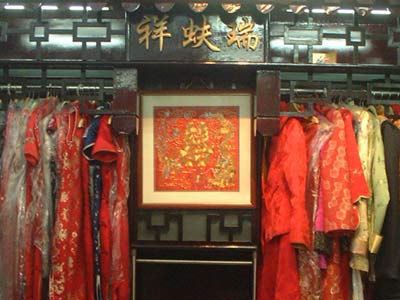








|
ћетки: китай истори€ происхождени€ шЄлк 丝绸 |
Ў®Ћ . 丝绸 |
ƒневник |
Ў®Ћ .
丝绸,是由蚕的蚕茧抽丝后编制取得的天然蛋白质纤维,再经过编制而成的纺织品,人们通过养蚕,当蚕结茧成蛹准备羽化成蛾时,将蚕茧放入沸水中煮,并及时抽丝。一个蚕茧可以抽出800-1200米的蚕丝。丝绸著名的光泽外表来自于像三棱镜般的纤维结构,这令布料能够以不同的角度折射入射光,并将光线散射出去。在中国,丝绸一词也指代人造的,具有与天然丝绸一样光泽的纺织品。
全新世大暖期(大西洋期)为中国带来了温暖的气候,令桑树和蚕的养殖,能於黄河流域广泛进行。傳說黃帝妻嫘祖發明「養蠶取絲」,惟丝绸究竟何时被发明尚具争议。考古学家在1998年河南荥阳青台遗址的一次考古中,发现了距今约5500年的丝绸碎片。另一种说法是在河姆渡遗址中人们已发现了纺织工具,借此可以推断,丝绸的使用至少不迟于良渚文化。不过世界上最具影响力的说法,是中国科学家在1958年考古发现的,距今公元前3700-前3100年(大汶口文化时期)的丝绸织品。
丝绸织品技术曾被中国垄断数百年,由于其在当时是一种复杂的工艺,又因其特有的手感和光泽,备受人们的关注,因而丝织品为工业革命以前,世界主要的国际贸易物资。最早丝绸织品只有帝王才能使用,但丝绸业的快速发展令丝绸文化不断的从地理上、社会上渗透进入中华文化。并成为中国商人对外贸易中一项必不可少的高级物品。
起初中国严密控制着丝绸织造业和养蚕业的技术流传,并禁止其流向外国。但朝鮮半島地區则在中国移民的协助下,于公元前200年成功实现养蚕技术的突破。此外,西域和田河流域(前500年-前300年)与印度(前300年之前)成功实现养蚕。不过罗马帝国则是在550年左右才得到蚕种并发展养蚕技术的:传说几位为东罗马帝国皇帝工作的僧侶将蚕种放在中空的手杖中,私自从中国带出,并辗转到达君士坦丁堡。虽然这个传说的可信度并不高,但随后的拜占庭人确实发展了丝绸编制技术,在皇宫庭院内设立蚕室和缫丝机,为皇帝服务。当时拜占庭所有的土产丝绸大多被皇室成员享用,剩余的材料也能以一个高昂的价格卖到市场上。
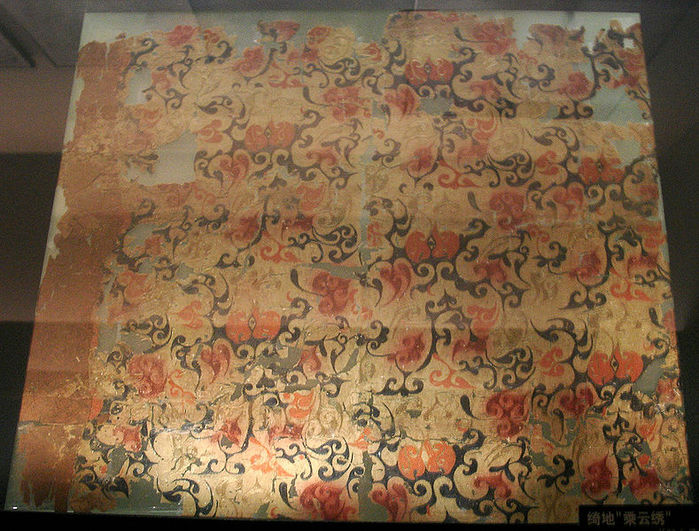
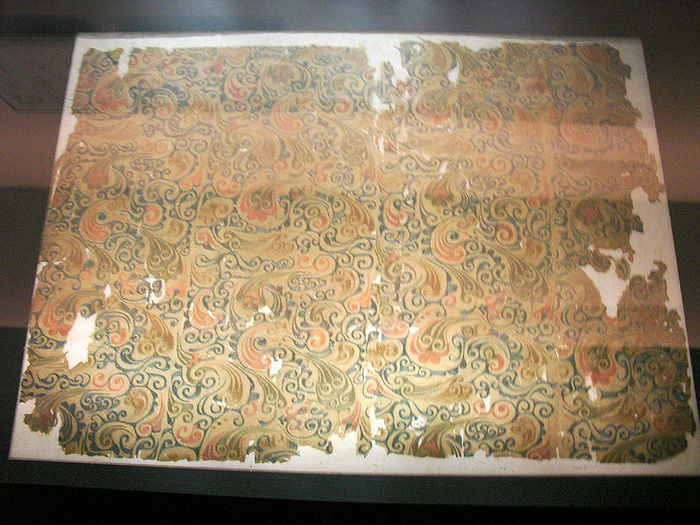
特性
絲綢質地輕、柔軟,強度最高的天然纖維之一,但一旦濕潤,會失去其20%的強度。其彈性也偏弱,倘若稍作拉長,已再無法拉長下去。暴露在太陽光下,韌性也會降低,並且會變色發黃。
一般而言,絲綢的成份主要是蛋白質和氨基酸,而後者比例則達50%。一旦弄髒會受被昆蟲滋擾。
絲綢是不良導電體,故易受靜電吸附,但也能有效地在冬天產生保暖功效。
絲綢染色性良好,但也容易變色,容易留下汗漬,而且在一般家庭里難以清洗,因為其對水敏感。
Brooklyn Museum - Sample Books of Brocade Designs (Kinran Mihoncho zu) - Keisai Eisen.jpg
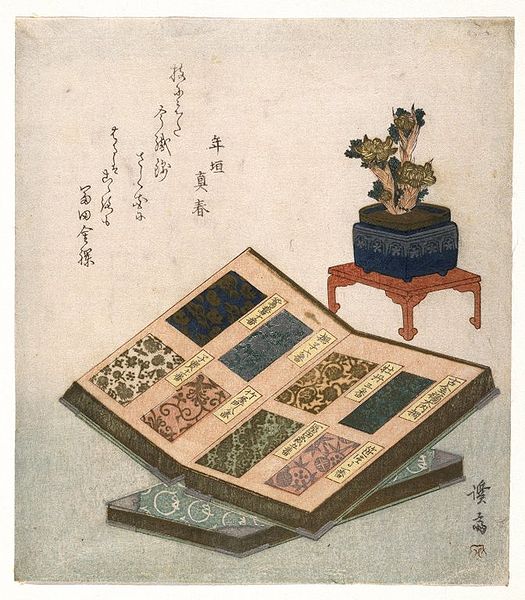
產地
作為傳統絲綢生產發源地,現今絲綢的產量以中國最多,其次是印度。而首十大絲綢生產地裡,只有羅馬尼亞是歐洲國家。

丝绸,是由蚕的蚕茧抽丝后编制取得的天然蛋白质纤维,再经过编制而成的纺织品,人们通过养蚕,当蚕结茧成蛹准备羽化成蛾时,将蚕茧放入沸水中煮,并及时抽丝。一个蚕茧可以抽出800-1200米的蚕丝。丝绸著名的光泽外表来自于像三棱镜般的纤维结构,这令布料能够以不同的角度折射入射光,并将光线散射出去。在中国,丝绸一词也指代人造的,具有与天然丝绸一样光泽的纺织品。
全新世大暖期(大西洋期)为中国带来了温暖的气候,令桑树和蚕的养殖,能於黄河流域广泛进行。傳說黃帝妻嫘祖發明「養蠶取絲」,惟丝绸究竟何时被发明尚具争议。考古学家在1998年河南荥阳青台遗址的一次考古中,发现了距今约5500年的丝绸碎片。另一种说法是在河姆渡遗址中人们已发现了纺织工具,借此可以推断,丝绸的使用至少不迟于良渚文化。不过世界上最具影响力的说法,是中国科学家在1958年考古发现的,距今公元前3700-前3100年(大汶口文化时期)的丝绸织品。
丝绸织品技术曾被中国垄断数百年,由于其在当时是一种复杂的工艺,又因其特有的手感和光泽,备受人们的关注,因而丝织品为工业革命以前,世界主要的国际贸易物资。最早丝绸织品只有帝王才能使用,但丝绸业的快速发展令丝绸文化不断的从地理上、社会上渗透进入中华文化。并成为中国商人对外贸易中一项必不可少的高级物品。
起初中国严密控制着丝绸织造业和养蚕业的技术流传,并禁止其流向外国。但朝鮮半島地區则在中国移民的协助下,于公元前200年成功实现养蚕技术的突破。此外,西域和田河流域(前500年-前300年)与印度(前300年之前)成功实现养蚕。不过罗马帝国则是在550年左右才得到蚕种并发展养蚕技术的:传说几位为东罗马帝国皇帝工作的僧侶将蚕种放在中空的手杖中,私自从中国带出,并辗转到达君士坦丁堡。虽然这个传说的可信度并不高,但随后的拜占庭人确实发展了丝绸编制技术,在皇宫庭院内设立蚕室和缫丝机,为皇帝服务。当时拜占庭所有的土产丝绸大多被皇室成员享用,剩余的材料也能以一个高昂的价格卖到市场上。


特性
絲綢質地輕、柔軟,強度最高的天然纖維之一,但一旦濕潤,會失去其20%的強度。其彈性也偏弱,倘若稍作拉長,已再無法拉長下去。暴露在太陽光下,韌性也會降低,並且會變色發黃。
一般而言,絲綢的成份主要是蛋白質和氨基酸,而後者比例則達50%。一旦弄髒會受被昆蟲滋擾。
絲綢是不良導電體,故易受靜電吸附,但也能有效地在冬天產生保暖功效。
絲綢染色性良好,但也容易變色,容易留下汗漬,而且在一般家庭里難以清洗,因為其對水敏感。
Brooklyn Museum - Sample Books of Brocade Designs (Kinran Mihoncho zu) - Keisai Eisen.jpg

產地
作為傳統絲綢生產發源地,現今絲綢的產量以中國最多,其次是印度。而首十大絲綢生產地裡,只有羅馬尼亞是歐洲國家。

|
ћетки: 丝绸 Ў®Ћ »“ј… |
»стори€ ита€. |
ƒневник |

»— ”——“¬ќ ƒ–≈¬Ќ≈√ќ »“јя.
«начение слова " итай" - ( от татарского kytai из тюркского, kytan Ц Ђсрединныйї). јнтичные авторы называли северные племена сЄрами (греч. serikon, лат. seres Ц по названию вывозимых из этой страны шелковых тканей), а южные Ц синами (ср. -лат. sinae Ц по названию династии правителей ÷инь). Ќа карте мира, изданной в конце XVI в. орденом иезуитов дл€ просвещени€ китайцев, их страна помещена в середине (этимологически слово Ђсрединныйї объ€сн€ют китайским названием маньчжурской народности Kitan).
»сследовани€ми археологов установлено, что территори€ ита€ была населена уже со времен нижнего палеолита. »менно в итае найдены самые древние остатки ископаемого человека (синантропа) вместе с примитивными каменными оруди€ми. Ѕлагопри€тные природные услови€ восточного ита€ способствовали тому, что в долине реки ’уанхэ и ее притоков очень рано Ч уже с 3 тыс€челети€ до н.э. по€вилось земледелие. «атем здесь возникли государства, которые нар€ду с ≈гиптом, ƒвуречьем и »ндией €вились наиболее ранними в истории человечества очагами культуры и искусства.
»стори€ культуры ƒревнего ита€ охватывает длительный период, насчитывающий около п€ти тыс€челетий своего существовани€. ¬ насто€щее врем€ еще не выработано единой точки зрени€ на ход социально-экономического развити€ древнекитайского общества. ѕо мнению некоторых исследователей, рабовладельческие отношени€, сложившиес€ ко 2 тыс€челетию до н.э., уже в середине 1 тыс€челети€ до н, э. сменились отношени€ми феодальными. ƒруга€ часть исследователей весь древний период, включа€ ’ань (3 в. до н.э. - 3 в. н.э.), относит к рабовладельческой формации. ¬о вс€ком случае дл€ истории искусства важно отметить, что, хот€ в культуре и в искусстве ита€ начина€ с середины 1 тыс€челети€ до н.э. по€вл€ютс€ новые черты, которые получают отчетливое развитие в искусстве периода ’ань, оно еще тесно св€зано с традици€ми всего предшествующего времени. ќчень важной особенностью культуры ита€ €вл€етс€ то, что с древнейших времен, с самого своего возникновени€, она развивалась непрерывно, сохранив многие древнейшие культурные центры на прот€жении веков. Ётим в значительной степени определилась устойчивость традиций в искусстве ита€. —воеобразный художественный стиль сложилс€ в итае очень рано, и, несмотр€ на изменени€, происходившие в течение последующего времени, некоторые его характерные черты не мен€ютс€ на прот€жении всего развити€ искусства - от древнейших времен вплоть до наших дней.

ультура ƒревнего ита€ достигла высокого уровн€. ”же в очень давние времена ученые ита€ сделали многие важные открыти€ в области астрономии, математики, медицины и других наук. ¬о 2 тыс€челетии до н.э. в итае существовала уже иероглифическа€ письменность. Ќесколько позднее были изобретены компас, а затем сейсмограф. ¬ середине первого тыс€челети€ до н.э. был составлен первый в мире звездный каталог, насчитывавший 800 светил. Ѕольшой высоты достигли литература и искусство. ƒостижени€ первого искусства легли в основу национальной художественной традиции ита€ и имели большое значение дл€ развити€ искусства многих других народов.
Ќаибольшего расцвета культура ƒревнего ита€ достигла в периоды ÷инь и ’ань, когда впервые произошло объединение разрозненных древнекитайских царств в единое итайское государство.

»скусство этого самого большого из древних государств складывалось на прот€жении многих веков из самых различных этнических источников, и €вл€етс€ симбиозом многих культур.
¬ IV тыс. до н. э. в бассейне р. ’уанхэ сложилась группа племен монголоидной расы (самоназвание Ђханьжэньї). —уществуют предположени€ о тибетском происхождении китайцев и о Ђсино-кавказскомї €зыковом родстве. ¬ столкновении с племенами южного происхождени€ сложилась цивилизаци€ Ўан (1765-1122 гг. до н. э.) с центром в г. јнъ€н. ¬ конце 2 тыс. до н. э. Ђшанцыї были завоеваны племенами „жоу. ќбъединение древних царств происходило при династи€х ÷инъ (632-628 гг. до н. э. ) и ’ань (206 г. до н. э. - 220 г. н. э. ). Ќа стади€х формировани€ этнической общности китайцы благодар€ природной восприимчивости легко впитывали достижени€ иных культур Ц ћесопотамии, ѕерсии эпохи —асанидов, буддийской »ндии, азиатских кочевых народов, эллинизированных ближневосточных племен. ¬ IV-VI вв. итай оказалс€ разделенным на —евер и ёг.
ћировоззрение и мироощущение китайцев существенно отличаетс€ от европейского. ¬ этой стране не было последовательного развити€ и смены художественных направлений и стилей, как в европейском искусстве. —амо пон€тие истории не имеет в итае признаков Ђдлительностиї, а искусство Ц эволюции. ’удожественные направлени€ не следуют одно за другим, а Ђстилиї и Ђшколыї св€зываютс€ не с различи€ми творческих методов, а с техническими приемами и материалами. ¬ итае Ђ... мы застаем необычайно устойчивый, до мелочей продуманный и эстетически переработанный быт, цельное и последовательное миросозерцание, сложный, но прочный сплав художественных стилей... —тилистическое единство китайского искусства Ц это результат не только глубокого проникновени€ китайских мастеров в природу вещей... , но прежде всего их искреннего и безупречного довери€ к жизни во всем ее разнообразииї. ¬ то врем€ как в западноевропейской цивилизации рождалс€ рационализм, в ближневосточной Ц мистицизм, в ÷ентральной јзии формировалась особа€ культура следовани€ течению жизни. ¬ итае Ђмерой всех вещейї оказалс€ не человек, а природа, котора€ бесконечна и поэтому неопознаваема. ¬ искусстве происходило не отражение жизни, а еЄ продолжение в движени€х кисти и мазках туши. Ќа этой своеобразной основе осуществл€лась Ђсамотипизаци€ї китайского искусства, предметом которого становилс€ не образ человека-геро€ и не духовные идеалы, а жизнь природы. ќтсюда особенный эстетический вкус и художественный такт традиционного искусства ита€. ¬ древних веровани€х китайцев обожествл€лись любые объекты природы: деревь€, камни, ручьи, водопады (однако более чЄтко эта тенденци€ выражена в синтоизме). –елиги€ считалась искусством жизни, а созерцательное мироощущение требовало полного и смиренного сли€ни€ с природой. ћудрецы ¬остока люб€т повтор€ть, что если дл€ де€тельного европейца, обуреваемого идеей покорени€ природы и демонстрации силы, нет большего удовольстви€, чем забратьс€ на вершину высокой горы, то дл€ китайца наибольшее счастье Ц созерцать гору у еЄ подножи€.


ѕо материалам книги: "»скусство ƒревнего ита€" Ќ.¬иноградова, фотографии вз€ты с сайта http://www.catsmob.com/ старые фотографии ита€.
|
ћетки: »скусство ƒревнего ита€ искусство китай культура развити€ истори€ ита€ |
FOLK SONGS OF THE YUGU MINORITY. |
ƒневник |
FOLK SONGS OF THE YUGU MINORITY.
Yugu Autonomous County in South Gansu is located in the middle of the Hexi Corridor and the north foot of the Qilian Mountains. The Yugu minority, named Yaohu'er or Lianglayugu'er in their own language, is a very special ethnic group. It holds no obvious patriarchal concept of reproduction or distinct awareness of male superiority. The minority is also a romantic ethnic group. As its own written language has lost, its culture, its history in particular, has to be passed down by folk singers of all historical periods. Folk songs of the Yugu minority have diversified contents, beautiful melodies, sprightly rhythm, and sharp ethnic characters. In tune and pattern, Yugu folk songs not only inherited some features of ancient Huns, but also absorbed some characters of layi of the Tibetans, jiuqu of the Mongolians, hua'er of the Hui minority, and banquet tune of the Tu minority, and ingeniously integrate various styles into one.
The Yugu people are good at singing and dancing. The loss of written language gives rise to the flourishing of oral literature of the ethnic group, especially the folk songs which retain many characteristics of folksongs of ancient Dingling, Turkic and Huihu minorities, and share a lot of similarities with modern Hungarian folk songs. The Yugu people like to sing folk songs. In history, there were many professional singers in the minority. They mainly sang for families holding funerals and weddings. Singing plays a very important role in their daily life. As a saying of the Yugu minority goes, "Even when I forget my homeland, I will not forget our language; even when I forget our language, I will not forget our songs".
By language and residential area, Yugu folk songs are divided into eastern folk songs and western ones. The former class is more rustic and bolder, close to Mongolian folk songs in tune; the latter is relatively gentle and deep, and inherits more traditions of Huihu folk songs. Yugu folk songs adopt the pentatonic scale, in which yu, zhi, and shang are most commonly used. As most librettos are in two lines, most tunes are single passages comprising two phrases. Single-phrase passages also account for a certain proportion. As the accent of words in eastern and western Yugu folk songs always falls on the last syllable, it is common to see the rhythmic pattern with a short head and a long end.
Fifths can be frequently found in Yugu folk songs. Generally speaking, it is adopted more in western folk songs than in eastern ones for the development of musical ideas. Conjunct motion is the basis for melodic lines of Yugu folk songs. They mostly consist of almost just conjunct motions. Disjunct motions are mostly disjunct upward/downward motions by fourths and fifths. The folk music works of the Yugu minority are simple in structure. Most of them are closely related to the way of production and living (like pasturing, rearing young animals, and stocking grass) and customs in ancient times. The librettos and poetic meters have much in common with Turkic and Mongolian folk songs recorded in ancient documents, and bear many features of ancient languages. Therefore, Yugu folk songs may have preserved many ancient elements.
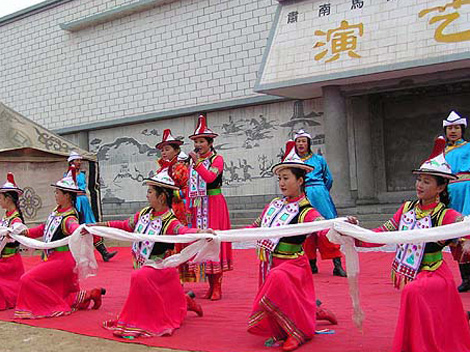
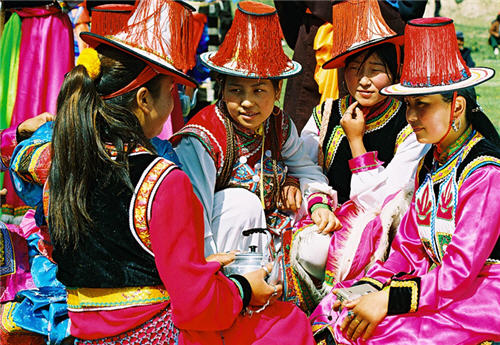

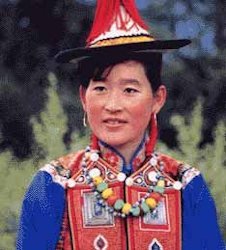
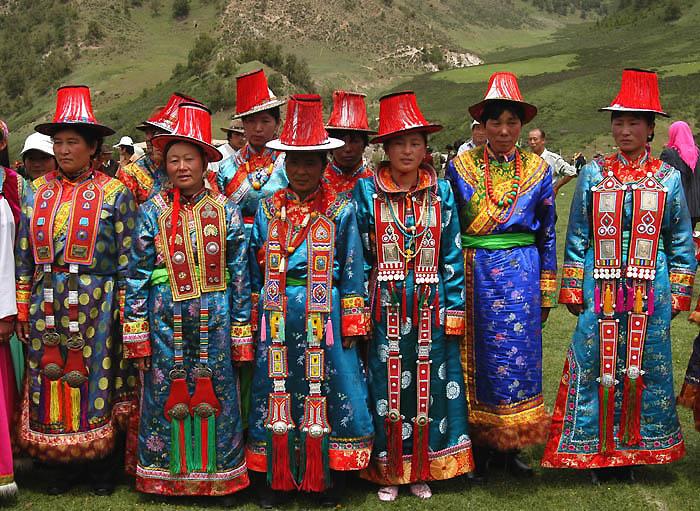
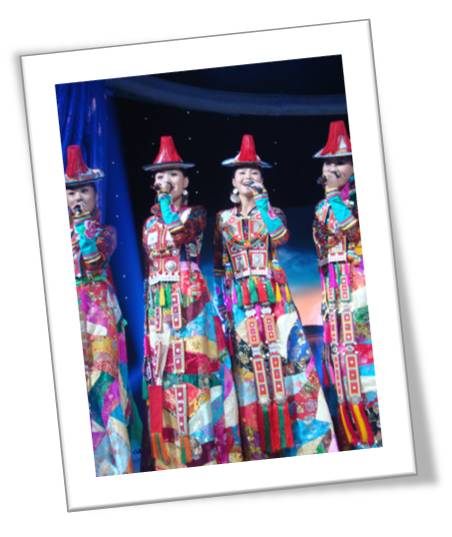
ѕо материалам с сайта: http://traditions.cultural-china.com
Yugu Autonomous County in South Gansu is located in the middle of the Hexi Corridor and the north foot of the Qilian Mountains. The Yugu minority, named Yaohu'er or Lianglayugu'er in their own language, is a very special ethnic group. It holds no obvious patriarchal concept of reproduction or distinct awareness of male superiority. The minority is also a romantic ethnic group. As its own written language has lost, its culture, its history in particular, has to be passed down by folk singers of all historical periods. Folk songs of the Yugu minority have diversified contents, beautiful melodies, sprightly rhythm, and sharp ethnic characters. In tune and pattern, Yugu folk songs not only inherited some features of ancient Huns, but also absorbed some characters of layi of the Tibetans, jiuqu of the Mongolians, hua'er of the Hui minority, and banquet tune of the Tu minority, and ingeniously integrate various styles into one.
The Yugu people are good at singing and dancing. The loss of written language gives rise to the flourishing of oral literature of the ethnic group, especially the folk songs which retain many characteristics of folksongs of ancient Dingling, Turkic and Huihu minorities, and share a lot of similarities with modern Hungarian folk songs. The Yugu people like to sing folk songs. In history, there were many professional singers in the minority. They mainly sang for families holding funerals and weddings. Singing plays a very important role in their daily life. As a saying of the Yugu minority goes, "Even when I forget my homeland, I will not forget our language; even when I forget our language, I will not forget our songs".
By language and residential area, Yugu folk songs are divided into eastern folk songs and western ones. The former class is more rustic and bolder, close to Mongolian folk songs in tune; the latter is relatively gentle and deep, and inherits more traditions of Huihu folk songs. Yugu folk songs adopt the pentatonic scale, in which yu, zhi, and shang are most commonly used. As most librettos are in two lines, most tunes are single passages comprising two phrases. Single-phrase passages also account for a certain proportion. As the accent of words in eastern and western Yugu folk songs always falls on the last syllable, it is common to see the rhythmic pattern with a short head and a long end.
Fifths can be frequently found in Yugu folk songs. Generally speaking, it is adopted more in western folk songs than in eastern ones for the development of musical ideas. Conjunct motion is the basis for melodic lines of Yugu folk songs. They mostly consist of almost just conjunct motions. Disjunct motions are mostly disjunct upward/downward motions by fourths and fifths. The folk music works of the Yugu minority are simple in structure. Most of them are closely related to the way of production and living (like pasturing, rearing young animals, and stocking grass) and customs in ancient times. The librettos and poetic meters have much in common with Turkic and Mongolian folk songs recorded in ancient documents, and bear many features of ancient languages. Therefore, Yugu folk songs may have preserved many ancient elements.






ѕо материалам с сайта: http://traditions.cultural-china.com
|
ћетки: FOLK SONGS OF THE YUGU MINORITY CHINA yugu традиции кита€ http://traditions.cultural-china.com/ Yugu Minority 裕固族 этнические народы кита€ китай |
THE YUGUR NATIONALITY. |
ƒневник |

THE YUGUR NATIONALITY.
In Chinese, 'Yugur' means 'wealth and solidity'. With a population of 13,719 as at the 2000 census, approximately 90 percent of the Yugur people live in the four areas of Sunan Yugur Autonomous County, and the rest in the Yugur village of Huangnibao area in Jiuquan city (a city in western Gansu Province). The minority has a long history that can be traced back to the year 3 B.C. They live in the mountainous areas, mainly by stock raising, and are typical nomads.
Language and Character:
Three languages are used by the Yugur ethnic minority: the western Yuhur language, a Turkic branch of the Altaic language family (also called Raohul), used by the Yugur people who live in the western part of the Sunan Yugur autonomous county; the eastern Yuhur language, a Mongolian branch of the Altaic language family (also called Engle), used by the Yugur people living in the eastern part of the autonomous county; and the Chinese language.
With regard to written characters, they don't have their own. Chinese characters are widely used amongst all the Yugur people.
Religion:
The Yugur people believe in Lamaism (the Yellow Religion). Other forms of spirit worship are also cherished by them, such as an original belief called the God Khan.
Food and Food Culture:
Only one dinner is eaten every day of which their staple foods are primarily rice, wheat and some mixed grain. As the Yugur people live by stock raising, they usually eat beef, mutton, and pork, as well as chicken and camel meat on which are put some garlic, soy sauce, and vinegar. Due to the special climatic conditions, fresh vegetables are rare, and only some potherbs such as the wild shallot, and leek can be found. Fresh mushrooms are the main vegetables in the fall. In addition, 'milk tea', which is usually mixed with fried noodles, plays a crucial role in the Yugur people's daily life.
The Yugur people are renowned for their hospitality. No matter when guests arrive, they will feast them with great kindness. Fragrant tea or milk tea will be immediately presented that lets each guest feel the Yugur people's friendliness. Singing and dancing performed by the local people will follow accompanied by wines and toasts by every member of the family. When festivals come, each family will bring their best food to treat their honored guests. Among all the delicious food, baked-mutton is the most special.
Crafts:
The Yugur people are deft at weaving and embroidering. They weave beautiful patterns on their carpets, pockets, checkreins and so on. Women are good embroiderers. A variety of patterns are elaborately designed with flowers, insects, grasses, and other pictures embroidered on their collars and sleeves.
Clothes:
The Yugur people have a special way of dressing. Men usually wear high-collared long gowns buttoned on the left, with red or blue waistbands. Women usually wear high-collar gowns overlain with a short waistcoat, and bound with red, purple or green waistbands on which colorful handkerchiefs are tied on the left. They also love to wear a trumpet-shaped red hat, with earrings, bracelets, and rings.
Architecture:
Like other nomadic nations the Yugur people live in tents. Before 1985, the tents were tapered and supported by four, six or nine stakes. However, since 1985, they have adopted the Tibetan-style tents with the square shape sewn by rugs made of goat's wool. Some of the tents are made of white canvas, on which are designed traditional pictures. As the seasons change, the people move their tents to a new place. Usually, a site with a sunny exposure and wind prevention is considered the best.
Marriage Customs:
Grand wedding ceremonies are held in the Yugur minority, which last two days for ordinary people and several days for rich ones. Some customs are quite peculiar. In one the bridegroom shoots three arrows (arrows that will not hurt anyone) to his bride and then breaks the arrows and the bow during the wedding ceremony. According to their culture, this means they will love and live with each other forever. Monogamy is adopted and marriage among people of the same surname and kin is strictly prohibited.
Other Traditions:
Many traditional outstanding cultures are greatly preserved by the Yugur people including legends, folk tales, proverbs, epics, allegories and ballads. In addition, their folk songs expressing their affections are of unique and graceful tunes and are sung by Yugur people of all ages.


»сточники: http://traditions.cultural-china.com, Dru C. Gladney (2004). Dislocating China: reflections on Muslims, minorities and other subaltern subjects. C. Hurst & Co. Publishers. p. 212. ISBN 1-85065-324-0. Retrieved 2010-10-31.
|
ћетки: THE YUGUR NATIONALITY china китай традиции кита€ этнические народы ита€ ∆Єлтые уйгуры (югуры хара-йогуры; кит. упр. 裕固族) 裕固族 |
The Yugur Nationality. |
ƒневник |

The Yugurs (Chinese: 裕固族; pinyin: Yùgù Zú), or Yellow Uyghurs as they are traditionally known, are one of China's 56 officially recognized nationalities, consisting of 13,719 persons according to the 2000 census.The Yugur live primarily in Sunan Yugur Autonomous County in Gānsù Province. They are Buddhists, unlike the Xinjiang Uyghurs who had converted to Islam.Some scholars say that the Yugur's culture, language, and religion, is closer to the original culture of the original Uyghur Confederation at Karakorum, than the culture of the modern Uyghur people of Xinjiang.
Name.
The nationality's current, official name, Yugur, derived from the Yugur's autonym: the Turkic speaking Yugur designate themselves as Yogïr (Yugur) or Sarïg Yogïr (Yellow Yugur), and the Mongolic speaking Yugur likewise use either Yogor or Šera Yogor (Yellow Yugur). Chinese historical documents have recorded these ethnonyms as Sālǐ Wèiwù'ěr or Xīlǎgǔ'ěr. During the Qing dynasty, the Yugur were also called 西喇古兒黃番 (Xilaguer Huángbo (Western Lagur Yellow Bo). "Bo" is the classical Chinese term referring to Sino-Tibetian speaking ethnic groups. In order to distinguish both groups and their languages, Chinese linguists coined the terms Xībù Yùgù (Western Yugur) and Dōngbù Yùgù (Eastern Yugur), based on their geographical distribution.
History.
The Turkic speaking Yugurs are considered to be the descendants of a group of Uyghurs who fled from Mongolia southwards to Gānsù, after the collapse of the Uyghur Empire in 840 AD, and soon established there a prosperous Ganzhou Kingdom (870-1036 AD) with capital near present Zhangye city on the foots of Nan Shan Mountains in the valley of the Ejin River (Black River). Population of this Kingdom, estimated at 300,000 in Song Dynasty chronicles, practised Manichaeism and Buddhism in numerous temples flourished throughout the country.
In 1037 the Yugur came under Tangut domination. They were forcibly incorporated into Tangut Kingdom, despite of fierce resistance, after the bloody war of 1028Ц1036 AD. Mahmut Kashgari who lived at the time in Kashgar stated that "Uyghur blood was pouring like a murmuring stream" during this war. The Mongolic speaking Yugurs are probably the descendants of one of the Mongolic speaking groups invading northern China during the Mongol conquests in the thirteenth century. The Yugurs were eventually incorporated in the Qing Empire in 1696, during the reign of the second Qing ruler, the Kangxi Emperor (1662Ц1723).
In 1893, Russian explorer Grigory Nikoleyaevich Potanin, the first Western scientist to study the Yugur, published a small glossary of Yugur words, along with notes on their administration and geographical situation. Then, in 1907, Gustaf Mannerheim visited the Western Yugur village of Lianhua (Mazhuangzi) and the Eastern Yugur temple of Kanglesi. Mannerheim was the first to conduct a detailed ethnographic investigation of the Yugur. In 1911, he published his findings in an article for the Finno-Ugrian Society.
Language.
About 4,600 of the Yugurs speak the Turkic Western Yugur language and about 2,800 the Mongolic Eastern Yugur language. The remaining Yugurs of the Autonomous County lost their respective Yugur language and speak Chinese. A very small number of the Yugur reportedly speak Tibetan. They use Chinese for intercommunication. Both Yugur languages are now unwritten, although vertical Uyghur script was in use in some Yugur communities until end of 19th century.
People.
The Turkic speaking Yugur mainly live in the western part of the County in Mínghuā District, in the Townships of Liánhuā and Mínghǎi, and in Dàhé District, in the centre of the County. The Mongolic speaking Yugur mainly live in the County's eastern part, in Huángchéng District, and in Dàhé and Kānglè Districts, in the centre of the County.
The Yugur people are predominantly employed in animal husbandry.
Religion.
The traditional religion of the Yugur is Tibetan Buddhism, which used to be practised alongside shamanism.

»сточники: http://traditions.cultural-china.com/, Dru C. Gladney (2004). Dislocating China: reflections on Muslims, minorities and other subaltern subjects. C. Hurst & Co. Publishers. p. 212. ISBN 1-85065-324-0. Retrieved 2010-10-31, Dru C. Gladney (2005). Pál Nyíri, Joana Breidenbach, ed. China inside out: contemporary Chinese nationalism and transnationalism. Central European University Press. p. 275. ISBN 963-7326-14-6. Retrieved 2010-10-31.
|
ћетки: 裕固族 китай этнические народы кита€ традиции кита€ china yugu minority yugu |
—“ј–џ≈ ‘ќ“ќ√–ј‘»» »« «јѕ–≈“Ќќ√ќ √ќ–ќƒј. |
ƒневник |
ћраморный мост.
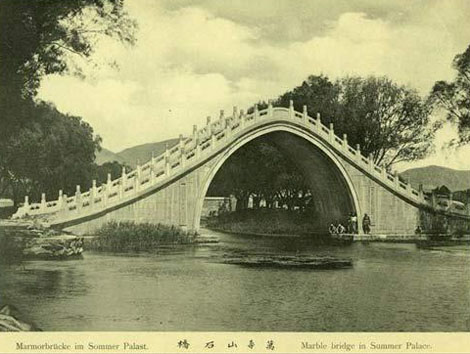
The Palace of Yu Kun
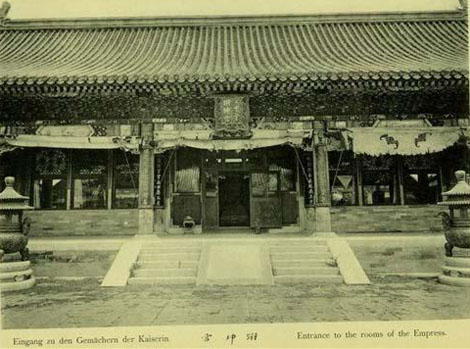
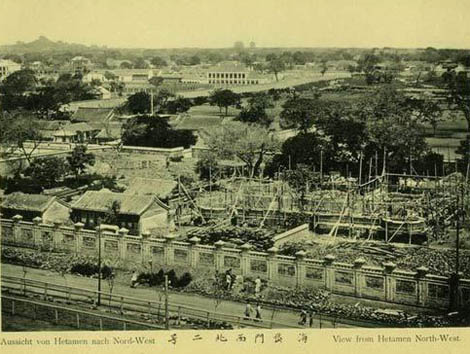
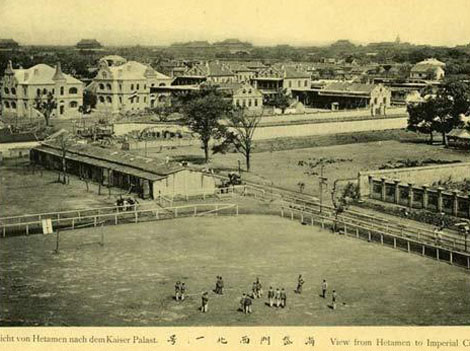
¬орота —уан ¬у.


The Palace of Yu Kun



¬орота —уан ¬у.

|
ћетки: старые фотографии из запретного города китай china |
| —траницы: | [2] 1 |






